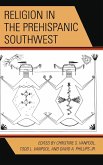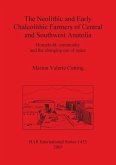- Broschiertes Buch
- Merkliste
- Auf die Merkliste
- Bewerten Bewerten
- Teilen
- Produkt teilen
- Produkterinnerung
- Produkterinnerung
An introduction to the history of the Puebloan Southwest from the AD 1000s to the sixteenth century.
Andere Kunden interessierten sich auch für
![Ancient Puebloan Southwest Ancient Puebloan Southwest]() Lynne SebastianAncient Puebloan Southwest72,99 €
Lynne SebastianAncient Puebloan Southwest72,99 €![Intercultural Relations between South and Southwest Asia Intercultural Relations between South and Southwest Asia]() Intercultural Relations between South and Southwest Asia145,99 €
Intercultural Relations between South and Southwest Asia145,99 €![The Archaeology of Art in the American Southwest The Archaeology of Art in the American Southwest]() Marit K. MunsonThe Archaeology of Art in the American Southwest58,99 €
Marit K. MunsonThe Archaeology of Art in the American Southwest58,99 €![Art in the Pre-Hispanic Southwest Art in the Pre-Hispanic Southwest]() Rados¿aw PalonkaArt in the Pre-Hispanic Southwest48,99 €
Rados¿aw PalonkaArt in the Pre-Hispanic Southwest48,99 €![Religion in the Prehispanic Southwest Religion in the Prehispanic Southwest]() Religion in the Prehispanic Southwest158,99 €
Religion in the Prehispanic Southwest158,99 €![Social Complexity in Southwest Iberia 800-300 B.C. Social Complexity in Southwest Iberia 800-300 B.C.]() T. Júdice GamitoSocial Complexity in Southwest Iberia 800-300 B.C.182,99 €
T. Júdice GamitoSocial Complexity in Southwest Iberia 800-300 B.C.182,99 €![The Neolithic and Early Chalcolithic Farmers of Central and Southwest Anatolia The Neolithic and Early Chalcolithic Farmers of Central and Southwest Anatolia]() Marion Valerie CuttingThe Neolithic and Early Chalcolithic Farmers of Central and Southwest Anatolia86,99 €
Marion Valerie CuttingThe Neolithic and Early Chalcolithic Farmers of Central and Southwest Anatolia86,99 €-
-
-
An introduction to the history of the Puebloan Southwest from the AD 1000s to the sixteenth century.
Produktdetails
- Produktdetails
- Verlag: Cambridge University Press
- Seitenzahl: 338
- Erscheinungstermin: 17. Mai 2011
- Englisch
- Abmessung: 229mm x 152mm x 18mm
- Gewicht: 491g
- ISBN-13: 9780521788809
- ISBN-10: 0521788803
- Artikelnr.: 21994740
- Verlag: Cambridge University Press
- Seitenzahl: 338
- Erscheinungstermin: 17. Mai 2011
- Englisch
- Abmessung: 229mm x 152mm x 18mm
- Gewicht: 491g
- ISBN-13: 9780521788809
- ISBN-10: 0521788803
- Artikelnr.: 21994740
John Kantner is the Vice President for Academic and Institutional Advancement at the School for Advanced Research and formerly an Associate Professor of Anthropology at Georgia State University. A native of New Mexico, he earned his BA from Colorado College and his Ph.D. from the University of California, Santa Barbara. His early research was on Spanish Colonial ethnohistory of the Southwest, and he has also conducted archaeological investigations in Costa Rica, the US Plains, and the US Rocky Mountains. Over the past several years, Dr Kantner's research has focused on the archaeology of the prehistoric Southwestern United States, with a particular interest in the development of sociopolitical complexity of the Chaco Anasazi. Dr Kantner currently directs the Lobo Mesa Archaeological Project, which focuses on prehistoric Anasazi groups who inhabited the Red Mesa Valley of northwestern New Mexico between AD 850 and 1200. The goal of this research is to identify the processes by which complex social and political regional institutions emerge from communities of comparatively simple horticulturists. Principles of human behavioral ecology and evolutionary theory provide the theoretical foundation for these investigations, while the analysis of prehistoric ceramics and regional spatial patterning provides the methodologies needed to interpret the archaeological remains. Publications by Dr Kantner can be found in Human Nature, the Journal of Anthropological Archaeology, the Journal of Archaeological Research and Historical Archaeology, and he coedited the 2000 book Great House Communities Across the Chacoan Landscape, published by the University of Arizona Press. Dr Kantner also continues his explorations of the use of new media both for enhancing public education and facilitating professional interaction.
1. The ancient Puebloan southwest: an introduction
2. 'The daylight world': the paleoenvironmental context for Puebloan history
3. Return to Ánosin Téhuli? The origins of Puebloan culture
4. The wrong middle places? Chaco canyon and the Mimbres mogollon
5. The migrations continue the end of Chaco and Mimbres
6. The AD 1200s: the great Pueblo period
7. The great abandonment
8. Finding Posi: the protohistoric Puebloan world.
2. 'The daylight world': the paleoenvironmental context for Puebloan history
3. Return to Ánosin Téhuli? The origins of Puebloan culture
4. The wrong middle places? Chaco canyon and the Mimbres mogollon
5. The migrations continue the end of Chaco and Mimbres
6. The AD 1200s: the great Pueblo period
7. The great abandonment
8. Finding Posi: the protohistoric Puebloan world.
1. The ancient Puebloan southwest: an introduction
2. 'The daylight world': the paleoenvironmental context for Puebloan history
3. Return to Ánosin Téhuli? The origins of Puebloan culture
4. The wrong middle places? Chaco canyon and the Mimbres mogollon
5. The migrations continue the end of Chaco and Mimbres
6. The AD 1200s: the great Pueblo period
7. The great abandonment
8. Finding Posi: the protohistoric Puebloan world.
2. 'The daylight world': the paleoenvironmental context for Puebloan history
3. Return to Ánosin Téhuli? The origins of Puebloan culture
4. The wrong middle places? Chaco canyon and the Mimbres mogollon
5. The migrations continue the end of Chaco and Mimbres
6. The AD 1200s: the great Pueblo period
7. The great abandonment
8. Finding Posi: the protohistoric Puebloan world.








